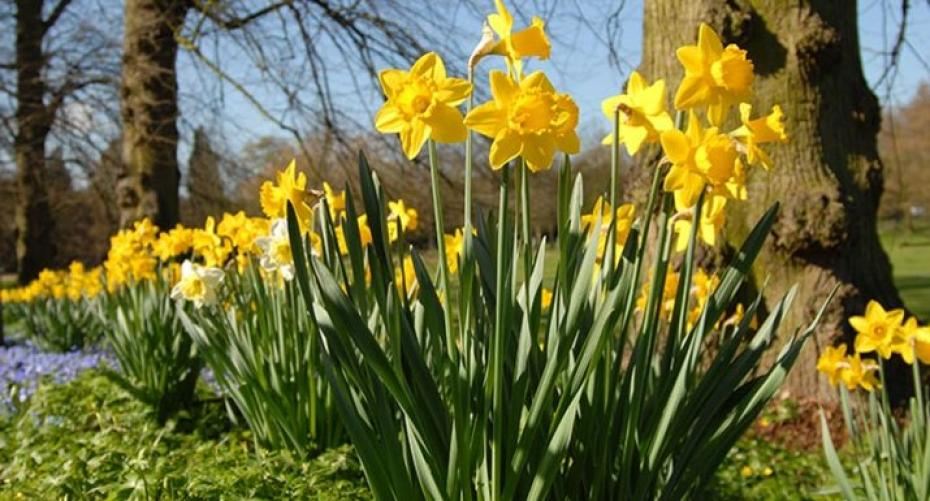Bulbs provide welcome colour in the woodland garden throughout the year
The choice of bulbs (or corms and tubers) for a deciduous woodland garden is limited but not impossible; as they have to finish flowering before the canopy closes and conditions become too dark, naturally most of the bulbs are spring flowering. The edge of the wood offers more possibilities as some summer flowering bulbs prefer the dappled shade. Many of these spring flowering bulbs are a good source of nectar for early flying insects. Plant them in large drifts as this looks more natural, eventually the bulbs will spread, creating a natural carpet of flowers.
With the odd exception most of the bulbs prefer a humus rich, well-drained soil. Don’t let them dry out after flowering as this will affect next year’s performance, so water well after flowering, or wait until it has rained, then put down a good layer of mulch to retain the moisture. This is especially important if they are planted under mature trees as they will take up a substantial amount of water, leaving the ground fairly dry.
Allium chameleon - white through to dark rose; flowers June/July; height 30cm (12”); plant on the wood edge; naturalises well
Anemone blanda - comes in pink, blue and white; flowers March/April; height 10 – 15cm (4 – 6”)
Anemone nemorosa (Wood Anemone) - comes in white, purple and lavender; flowers March/April; height 10cm (4”); naturalises well forming a carpet
Camassia leichtlinii - blue or white star-like flowers; flowers May/June; plant on wood edge; height 30 – 90cm (12 – 36”)
Chinodoxa forbesii (Glory of the Snow) - blue star-like flower; flowers March/April; height 15cm (6”); add grit to the planting hole if the soil is heavy; leave the flower heads after flowering as they spread by seed
Colchicum autumnale (Autumn Crocus, Naked Lady) - colour purplish pink; flowers September/October; height 10cm (4”); naturalises well; flowers after leaves have died back

Crocus tommasiniannus - flower February/March; recommended varieties: ‘Whitewell Purple’, ‘Ruby Giant’, ‘Barr’s Purple’; height 10cm (4”); naturalises well; good for early insects
Cyclamen coum - comes in shades of pink from pale pink to dark magenta; flowers December/April; height 10cm (4”); naturalises well forming a carpet
Cyclamen hederifolium - comes in white and shades of pink; flowers autumn to spring; height 10cm (4”); naturalises well forming a carpet
Cyclamen purpurascens - colours vary from pale to dark pink; flowers June/September; height 10cm (4”)
Eranthus hiemalis (Winter Aconite) - small yellow flowers in late winter/early spring; when planting dry tubers don’t expect them all to survive, there is a better survival rate when planting growing plants ‘in the green’; height 10cm (4”); naturalise well once established
Erythronium (Dog’s Tooth Violet) - comes in yellow, pink or white; flowers March/April; height 12 – 30cm (5 – 12”); naturalises well
Fritillaria meleagris alba - white; flowers April/May; height 20cm (8”); naturalises well; don’t let them dry out in summer
Galanthus (Snowdrop) - small white bell-like flowers; flower January/March; height 10 – 20cm (4 – 8”)

Hyacinthoides non-scriptus (English Bluebell) - violet-blue flower; flowers May; height 20 – 40cm (8 – 16”); slight fragrance; naturalises well eventually carpeting the woodland; classic woodland flower; don't be tempted to grow the much stronger Spanish bluebell as there is a problem with it hybridising with the English bluebell
Muscari (Grape Hyacinth) - dark blue/purple flower; flowers March/April; height 20cm (8”)
Narcissi lobularis (Lent Lily) - small pale yellow flower; flowers February/ April; height 20 – 35cm (8 – 14”); wild daffodil which naturalises well
Narcissi poeticus actaea (Pheasant Eye; Poet’s Narcissi) - large white petals with a small red and yellow eye; flowers April; height 40cm (16”); fragrant; naturalises well

Puschkinia scilloides libanotica (Russian Snowdrops) - white/ice-blue flower with a darker blue stripe down the centre of each petal; flowers March/April; height 12cm (5”); slow to establish; doesn’t like being moved so plant in the final planting position, it may not flower the first year after planting or after being moved
Scilla - comes in white, pink and blue; flowers March/April; height 15cm (6”)
Trillium - dark red or white flowers above three large leaves; flowers March/mid-April; height 25cm (10”); spread well once established




![Kingsbury-bench-05[1].jpg](http://www.hayesgardenworld.co.uk/cdn/shop/files/Kingsbury-bench-05_5B1_5D.jpg?v=1712162737&width=1500)
![Kingsbury-bench-01[1].jpg](http://www.hayesgardenworld.co.uk/cdn/shop/files/Kingsbury-bench-01_5B1_5D.jpg?v=1712161065&width=1500)
![tw17a-4947_0[1].jpg](http://www.hayesgardenworld.co.uk/cdn/shop/files/tw17a-4947_0_5B1_5D.jpg?v=1712161495&width=1500)
![tw17a-4947_tenbury_5ft[1].jpg](http://www.hayesgardenworld.co.uk/cdn/shop/files/tw17a-4947_tenbury_5ft_5B1_5D.jpg?v=1712161172&width=1500)
![tw17a-4952_tenbury_4ft[1].jpg](http://www.hayesgardenworld.co.uk/cdn/shop/files/tw17a-4952_tenbury_4ft_5B1_5D.jpg?v=1712161034&width=1500)
![thumbnail_IMG_1565-kik_2[1].jpg](http://www.hayesgardenworld.co.uk/cdn/shop/files/thumbnail_IMG_1565-kik_2_5B1_5D.jpg?v=1712226536&width=1500)
![thumbnail_IMG_1565-kik_1[3].jpg](http://www.hayesgardenworld.co.uk/cdn/shop/files/thumbnail_IMG_1565-kik_1_5B3_5D.jpg?v=1712159637&width=1500)



![WD-XgESA[1].jpeg](http://www.hayesgardenworld.co.uk/cdn/shop/files/WD-XgESA_5B1_5D.jpg?v=1712159609&width=1500)